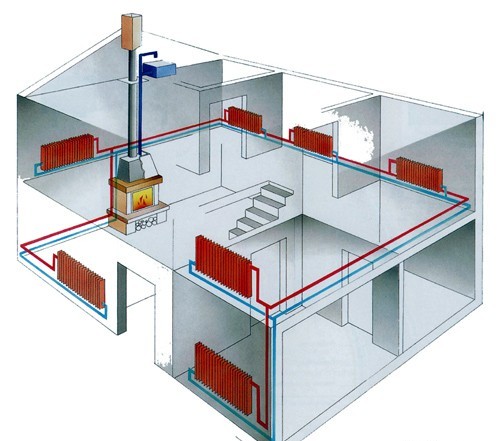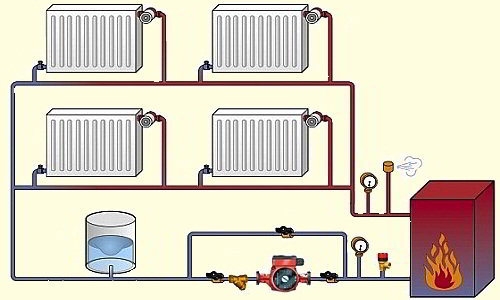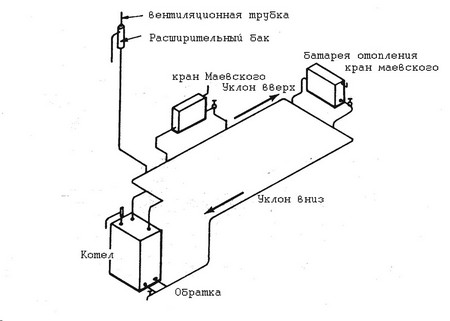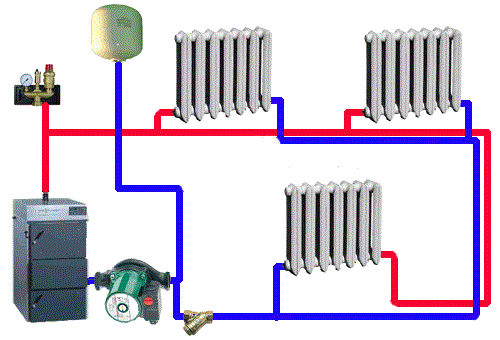When building your own homes, the correct organization of the heating system is one of the main processes. From how correctly it will be framed, it largely depends not only to comfortable accommodation, but also the volume of costs for its service. Therefore, carefully take care of the choice of the appropriate principle of the heating device and all the parts for a complete set of equipment to ensure its uninterrupted functioning.
Content
Sequence of the section of the heating of a private house
The principle of creating a process of heating is no different from the arrangement of other engineering systems. Sequencing:
- Choosing a suitable type of energy.
- Creating a heating layout scheme.
- Selection of suitable parts.
- Installation of the system according to plan.

Important! Be sure to follow the proposed sequence of stages, carefully thinking in advance all the nuances. Only with this approach the created heating system will meet the specified requirements.

How to choose the right source of energy?
In this regard, several options are most often used. When choosing the most practical and affordable, focus on such criteria:
- financial opportunities;
- rational use of energy, given the specific features of the design of the whole house;
- professional installation skills;
- aesthetic type of finished system.

Popular Heating System Wiring Solutions:
- Air. Until recently, this principle was the only reasonable way to maintain a normal temperature regime in the room. The main device for heating at the house served a furnace or fireplace. With the development of technologies, this method became irrelevant, since the warming occurs quite slowly. In addition, there is a chad that affects the quality of air. Nowadays, fireplaces, as well as ovens have long been used exclusively in decorative purposes, to give the interior of the original color.

- Electricity. This option is advantageously distinguished by simplicity of operation, which contributes to the maximum automation. But despite this, we note one fairly essential nuance, which is the main reason for the refusal of electricity as the main source for heating at home, is the highness of the energy itself. Given the rather high consumption indicators for the full functioning of the system, the rational solution will be the installation of electrical heating only in those rooms where there is no need for a stable comfortable temperature, such as a garage or attic. As the only way of heating a residential private house, especially a large area, the choice of this option is far from the most practical.

- Water. Wiring heating in a private house this way is characterized by high reliability and ease of operation. In addition, it is impossible not to note the available cost, both materials for the design of the system and the very source of heat. The principle of the organization is to circulate fluid - technical water, inside the paved pipeline, heating and the flow of which occurs through the boiler, and the heat exchange is carried out using batteries. The main disadvantage of this laying of heating is the complexity of the design process. Therefore, it is at this stage, when choosing a water system, be particularly attentive and neat, accurately carrying out all measurements and taking into account the compliance of the complex of requirements with the technical capabilities of the building.

Important! Given all the above features of the options for heating systems for a private house, it is not surprising that it is the last way that is most in demand. Below are some technologies and rules with which you will certainly familiarize yourself in order to pick up suitable for your home method of laying heating pipes.
Basic elements of the water heating system
The entire heating chain consists of several mandatory elements, the installation of which is carried out in a clearly defined sequence:
- Boiler.
- Pipes.
- Safety valves.
- Circulation pump
- Manometer.
- Expansion tank
- Radiators.

Important! Each item carries its functional load, therefore, when choosing a configuration, pay special attention to the quality of products in order to prevent the occurrence of failures in the work of the finished system due to the unscrupulousness of the manufacturer.
What to choose a heating scheme?
There are two basic principles of the structure of the heating system scheme:
- one-connecting;

- double-circuit.

Important! Each of these types has its advantages, disadvantages and specific recommendations on rational use, taking into account the design features of the building, which will be very carefully attributed when choosing a suitable method of heating device of its own private house.

Features design and operation of single-loop system
The principle of operation of such a heating device is a series connection of all system components into a single closed circuit. In this hot water, which occurs after the supply of the heating boiler and radiators in the duct extends along the entire line in one direction. 
Given this feature of the system structure, natural its shortcoming manifests itself in a gradual decrease when applying heat level in each subsequent battery. Therefore, if you use it in a large room at the end of the chain of the room will be much slower and not as well warm. Another disadvantage is the difficulty in carrying out repairs, if necessary. In this case, it is impossible to carry out the restoration of separate sections, will certainly require a complete shutdown of the entire system. 
Important! Given these features of the device, it is expedient to use only a single-wiring buildings for the small area - 100 m2. In this case, it will provide a quality heating at a safe functioning.
What is the difference unit two pipe heating wiring?
The principle design of such a system is characterized as follows:
- Water supply is carried out in the main line of pipes, laid in the basement or under the floor coating.
- The backbone of two types of risers is made from the main line.
- From one riser, the heated water is fed to each battery.
- In the second one comes only recycled chilled liquid. On this rising water returns back to the boiler.
Important! When creating a discharge layout, each radiator necessarily is equipped at the inlet pipes from one group, and at the output - from the other.

Advantages of the two-kontrary system
This principle of heating is beneficially distinguishes several sufficiently important points:
- Stable heating of large areas.
- Uniform distribution of heat.
- The ability to independently adjust the temperature mode with the inclusion and disconnection of individual elements of the heating device chain.
- Lack of heat loss as fluid circulation in the pipeline, which significantly reduces the cost of the energy source.

Important! Despite this list of indisputable advantages, keep in mind and the main disadvantage of the two-pipe layout is the increased complexity of planning the schema and installation of the entire system. To fulfill these works, professional design skills, processing and compounds of various building materials and equipment will certainly be required. Otherwise, the result will not only be not enough proper functioning of the system, but also the emergence of emergency situations with the threat to the health and life of all residents of the house.
How to properly design a two-circuit heating system?
In case you decide to give preference to this particular type, be sure to decide in advance with the type of line wiring. In this regard, two ways are distinguished:
- Heating with lower wiring. In this case, the feed and reducing tube is located below the battery level. That is, heated technical water and enters the radiator, and is removed from it from it. When choosing such a principle, be sure to pay extreme attention to the creation of an obstacle to the formation of air traffic jams. A fairly effective way is to install cranes of Maevsky when connecting a pipeline with radiators.

Important! Browse the video in which an example is clearly shown an example of a heating with a lower wiring of a wooden house.
- Heating with top wiring. With the arrangement of such a system, the flow of heated water is laid over the installation level of radiators. The most popular solutions in this case are installation in the ceiling or chain wiring in the attic. Given this feature, take into advance that you will need additional costs for designing risers in each room, along which from the main pipeline, from the boiler water will be vertically fed into radiators. For the output of the exhaust fluid, lay the line under the radiators. Air traffic jams when creating heating with top wiring are removed using special expansion tanks.

What do you pay attention to the design?
When creating a laying circuit, the heating is carefully attributed to the following points:
- If possible, minimize the number of joints and turns in the system circuit.
Important! Such an approach will not only facilitate the implementation of all installation work, but also affect the quality of operation, since the bends increase the pressure inside the system.
- Patch the diameter according to the length of the system and the pressure in it.

- When choosing a material material, give preference to copper or polyethylene products that provide long-term quality operation.
- Distribution of pipes from the standing end the lock valves to reduce the risk of emergency situations and facilitate the performance of repair work if necessary.
- If you want to make a hidden pipe system, consider the device in such a way as to save free access to them.
Important! Browse the video in which the example of the wiring scheme of the heating line and the main points of installation work on the installation of equipment are shown in detail.
Conclusion
With extreme caution and attentiveness, carry out all the work on the arrangement of the heating system. If you are not sure about your knowledge and skills, be sure to enlist the help of professionals at the stage that seems to be particularly difficult to you or incomprehensible. Only such an approach will not allow not to worry about the risk of problems already at the end of all construction and finishing work, and will provide not only comfortable accommodation in their own home, but also safety.























